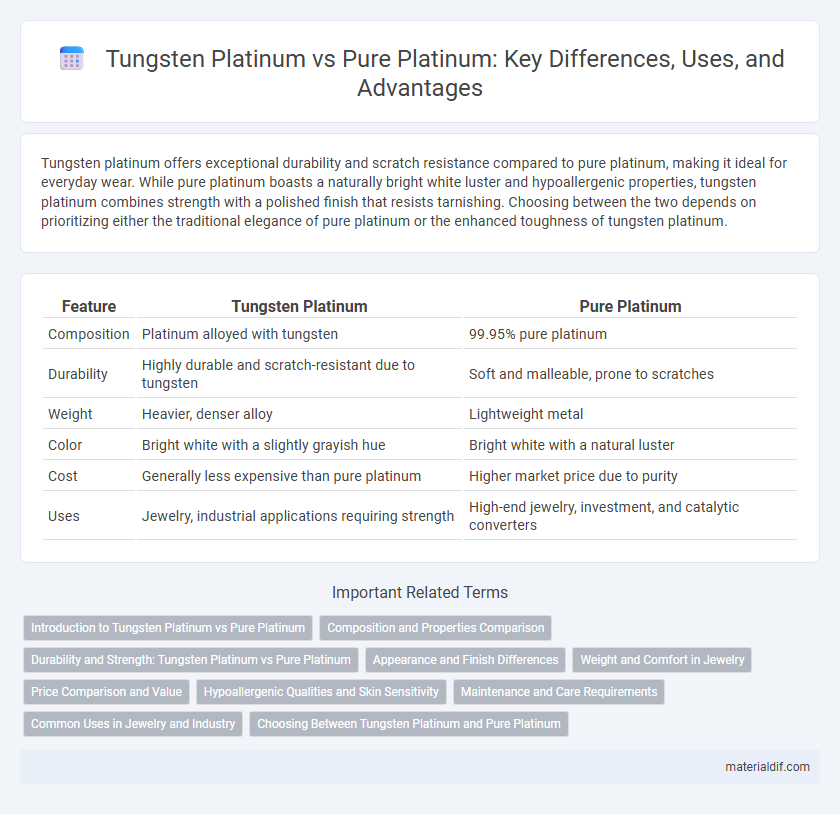Tungsten platinum offers exceptional durability and scratch resistance compared to pure platinum, making it ideal for everyday wear. While pure platinum boasts a naturally bright white luster and hypoallergenic properties, tungsten platinum combines strength with a polished finish that resists tarnishing. Choosing between the two depends on prioritizing either the traditional elegance of pure platinum or the enhanced toughness of tungsten platinum.
Table of Comparison
| Feature | Tungsten Platinum | Pure Platinum |
|---|---|---|
| Composition | Platinum alloyed with tungsten | 99.95% pure platinum |
| Durability | Highly durable and scratch-resistant due to tungsten | Soft and malleable, prone to scratches |
| Weight | Heavier, denser alloy | Lightweight metal |
| Color | Bright white with a slightly grayish hue | Bright white with a natural luster |
| Cost | Generally less expensive than pure platinum | Higher market price due to purity |
| Uses | Jewelry, industrial applications requiring strength | High-end jewelry, investment, and catalytic converters |
Introduction to Tungsten Platinum vs Pure Platinum
Tungsten Platinum is an alloy combining tungsten's high hardness and durability with platinum's natural luster and corrosion resistance, creating a material often used in jewelry and industrial applications. Pure platinum, with a purity of 95-99%, is known for its exceptional malleability, hypoallergenic properties, and resistance to tarnishing, making it highly valued in fine jewelry. Tungsten Platinum offers increased scratch resistance compared to pure platinum but may lack the same level of malleability and traditional prestige associated with pure platinum.
Composition and Properties Comparison
Tungsten platinum is an alloy combining platinum with tungsten, enhancing hardness and wear resistance compared to pure platinum's softer and more malleable nature. Pure platinum consists of nearly 99.95% platinum, offering superior ductility and resistance to tarnish but lower tensile strength. The tungsten addition increases density and durability, making tungsten platinum suitable for jewelry and industrial applications requiring enhanced scratch resistance.
Durability and Strength: Tungsten Platinum vs Pure Platinum
Tungsten platinum alloys exhibit superior durability and strength compared to pure platinum, making them more resistant to scratches and deformation in everyday wear. While pure platinum is valued for its natural luster and malleability, its softness can lead to easier dents and surface wear over time. Tungsten platinum combines the hardness of tungsten with the precious metal properties of platinum, resulting in an ideal balance for long-lasting jewelry and industrial applications.
Appearance and Finish Differences
Tungsten Platinum offers a darker, gunmetal gray appearance with a polished finish that maintains its sheen longer compared to the bright white, lustrous shine of pure platinum. Pure platinum's natural silvery-white color provides a classic, high-reflective finish that can develop a patina over time, adding character but requiring occasional polishing. In contrast, tungsten platinum's harder surface resists scratches and dullness, making it ideal for durable, low-maintenance jewelry.
Weight and Comfort in Jewelry
Tungsten platinum blends offer increased density, making jewelry pieces heavier yet more durable compared to pure platinum, which is lighter and prized for its natural hypoallergenic properties. The substantial weight of tungsten platinum is often favored for statement pieces, while pure platinum provides superior comfort due to its softness and breathability on the skin. Jewelry lovers seeking enduring heft and scratch resistance may choose tungsten platinum, whereas those prioritizing lightweight comfort often prefer pure platinum.
Price Comparison and Value
Tungsten platinum, an alloy combining tungsten's durability with platinum's luster, generally costs less than pure platinum due to the inclusion of a less expensive metal. While pure platinum offers superior purity and natural corrosion resistance, tungsten platinum provides enhanced hardness and scratch resistance, delivering better value for users prioritizing longevity. Price comparison reveals pure platinum's higher market value, but tungsten platinum's blend offers a cost-effective alternative without significantly compromising the precious metal's luxury appeal.
Hypoallergenic Qualities and Skin Sensitivity
Tungsten platinum alloys often contain metals like cobalt or nickel, which can cause allergic reactions in individuals with sensitive skin, whereas pure platinum is naturally hypoallergenic and less likely to trigger irritation. Pure platinum's high purity and non-reactive properties make it the preferred choice for those with metal allergies or skin sensitivities. Jewelry made from pure platinum ensures durability and a safe, comfortable wear for sensitive skin types compared to tungsten platinum alternatives.
Maintenance and Care Requirements
Tungsten platinum alloys exhibit higher resistance to scratches and wear compared to pure platinum, reducing the frequency of polishing needed to maintain their luster. Pure platinum, while softer, requires more regular maintenance such as professional cleaning and occasional replating to preserve its bright, untarnished appearance. Both materials benefit from avoiding harsh chemicals and abrasive cleaners, but tungsten platinum offers a more durable option for low-maintenance jewelry care.
Common Uses in Jewelry and Industry
Tungsten platinum alloys are favored in industrial applications due to their enhanced hardness and resistance to wear, making them ideal for cutting tools, electrical contacts, and high-durability jewelry like rings and bracelets. Pure platinum, valued for its natural luster, hypoallergenic properties, and corrosion resistance, is predominantly used in fine jewelry such as engagement rings, necklaces, and luxury watches. While tungsten platinum offers increased durability, pure platinum remains preferred for its purity and traditional appeal in high-end jewelry craftsmanship.
Choosing Between Tungsten Platinum and Pure Platinum
Choosing between tungsten platinum and pure platinum depends on factors such as durability, weight, and price. Tungsten platinum offers exceptional hardness and scratch resistance, making it ideal for everyday wear, while pure platinum is valued for its natural luster, hypoallergenic properties, and traditional prestige. Assessing your priorities in terms of maintenance, comfort, and investment will guide the best choice for jewelry or industrial applications.
Tungsten Platinum vs Pure Platinum Infographic

 materialdif.com
materialdif.com